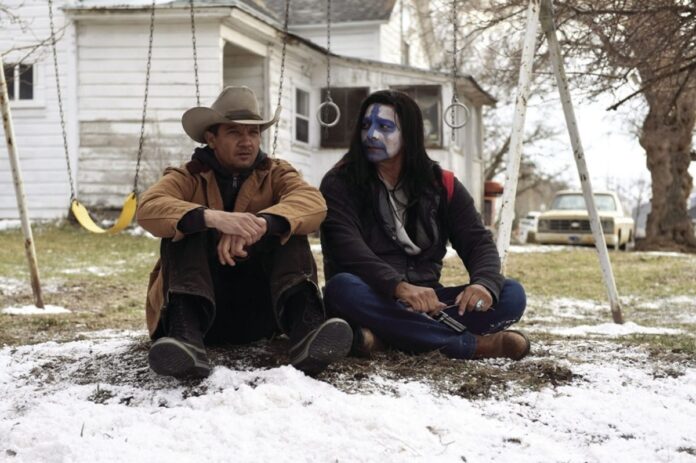BY BROOKE CORSO
On a stark, freezing night, a young woman tears barefoot across a snowy plain, the mountains and moon at her side. She runs until her body collapses from exhaustion and exposure. It isn’t until a Game and Fish department hunter ventures into the wilderness to track coyotes that her frozen body is found a few days later, and the limitations of justice for her are exposed. Wind River is, for all its merits and faults, less about the girl and more about the ravages to and from the land surrounding her and her Native American community, where it is too easy to abandon and too convenient to forget.
Writer-director Taylor Sheridan (“Sicario,” “Hell or High Water”) has written about characters well-versed in but existing outside the law, whose lives are forever solitary even in society. Here, hunter Cory Lambert (Jeremy Renner) is recently divorced from his wife, Wilma (Julia Jones) and trying to be present for his young son, Casey (Teo Briones), even as the grief over his deceased daughter, Emily, is still fresh for everyone. Emily died under suspicious circumstances after a small house party and the unresolved questions still haunt her parents. When Emily’s friend, Natalie (Kelsey Asbille), is found dead in the snow with signs of rape and pulmonary embolism, signifying she ran until her lungs burst, the past returns for Cory, who hesitantly becomes involved in the case after an inexperienced FBI agent (Elizabeth Olsen) arrives on the Reservation to work with a local chief (Graham Greene) in the Bureau of Indian Affairs.
Ben (Greene) moves deliberately, although Agent Jane Banner (Olsen) would describe him as tediously slow. “Don’t look at me,” he tells her after receiving frustrating autopsy results on Natalie, “I’m used to no help!” Banner has flown from Las Vegas to western Wyoming as the nearest agent the FBI could muster, and her lack of preparation (she has no warm clothes) and experience in Indian Affairs is indicative of the lack of urgency and respect placed on the investigation of a Native American woman on tribal land. The scene where Ben and Jane investigate some local toughs in a dilapidated trailer shows her tenacity and skill with a gun after being sprayed with mace, but the reluctance of locals to speak openly with her and her ignorance of culture and custom compile the roadblocks toward solving the case.
Sheridan illuminates both the visible and invisible barriers between the Native American community and the white residents of Lander, the systematic isolation and repression of the Shoshone and Arapaho people within the state by the government, and the disconnect between those who mean to help with their objectification of those who need it. Masterfully, he shows such barriers in the blocking of characters within confined spaces, in the change in tone and formality of dialogue, and in the often claustrophobic negative spaces — be they as vast as a craggy mountainside or a tiny, cluttered office.
The treatment of Natalie as a character throughout the film mostly shows her as an object for piercing eyes — of lust, of harm, and later as part of a crime scene — while her main displayed act of agency led to her painful and solitary death. To get out of Wyoming and towards a life of possibility seems like an ongoing but furtive pipe dream for those who were born into and exist in a world of wolves. When Banner goes to speak with Natalie’s family after her autopsy, she is literally and figuratively caught between the mother’s grief in the bedroom and Cory consoling the father on the front porch. She is an intruder in their world (even Cory would not be welcome had he not shared a similar experience with his daughter, and even then, he remains outside the house), and her presence there is both disheartening and terribly naive.
Clarice Starling, she is not. While Olsen’s diminutive size (she is often shown among much taller men) and wide-eyed persistence draw comparisons to Thomas Harris’s haunted heroine, there is a lack of intuition about the unique circumstances and characters with whom she must interact and respond in kind, moulding herself in a tenuous balance of what the male agents and officers perceive her to be and what she needs to do for the job. It makes Jane appear as more of an unprepared novice than an inexperienced but astute observer, and it hinders both the progress of the investigation and the flow of the film. Several tense scenes are met with frustration over the poor police work, and Renner’s character’s adeptness with a rifle and knowledge of the terrain make the FBI agent nearly obsolete. Indeed, when we finally see the villains, they are so dastardly evil and irretrievably stupid in their actions that the procedural work of the investigators seems even more hazardous and sloppier in retrospect.
While it is satisfying to see retribution on those involved in the assault, there is an underlying emptiness to the conclusion that is echoed in the surrounding natural world where the freezing wind bites the bark of the trees. There is little consolation that will bring back possibility and hope, and two fathers sit and gaze toward the horizon.
The film opens in theaters Aug. 18.
C+
“Wind River” (2017)
STARRING Jeremy Renner, Elizabeth Olsen, Graham Greene, Gil Birmingham, Jon Bernthal, Kelsey Asbille
DIRECTOR Taylor Sheridan
MPAA RATING R





